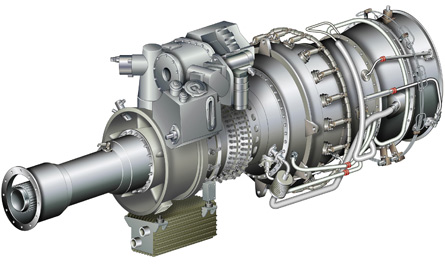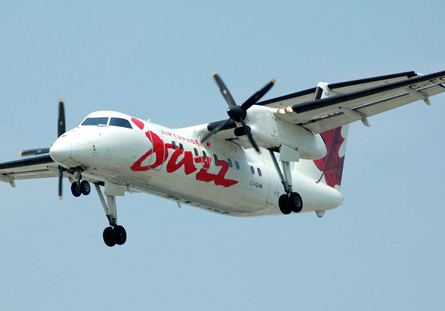A classic engine duel is beginning to take shape in a category often thought extinct at the dawn of the second century of commercial aviation: the untapped market sector.
Not since the late 1960s - when the first generation of turbojet airliners drove the Allison T56-powered Lockheed L-188 Electra out of commercial service - has there been so much serious consideration of a 90-seat regional airliner powered by turboprop engines.
 |
|---|
© General Electric Specifications of the GE38 are still a protected secret |
With the price of a barrel of oil stubbornly hovering above $100 and orders for 70-seat turboprops continuing to accumulate, ATR, Bombardier and perhaps other manufacturers are actively considering the most logical next step.
Their interest has not gone unnoticed by the world's engine makers. Always plotting the airframers' next move two or three years in advance, the engine suppliers can be counted on to give away the future.
It promises to be an unusually wide-open competition. A 90-seat airliner demands a powerplant in a size class unknown to the commercial sector. The world's militaries have found rotorcraft applications for engines generating between 5,000-7,500shp (3,730-5.595kW), but the regional turboprop market has never required more power than the very low end of that range.
In the absence of an established or dominant engine supplier, the airframers may enjoy a true competition when they are ready to launch their new turboprop designs.
One option will come from Pratt & Whitney Canada (P&WC), which practically invented the modern regional turboprop 30 years ago and has confirmed a next-generation turboprop engine development programme.
Competing to grab market share, meanwhile, will be General Electric (GE), a minor player in the regional turboprop sector to date. GE's CT7 powerplant is more widely known in the commercial helicopter world, but the manufacturer believes it now has a potential market leader in the fixed-wing sector with a civil derivative of the US military-funded GE38.
Both programmes are active. GE confirms the second test engine was shipped to Sikorsky for the CH-53K programme on 16 February. P&WC is in initial testing of the architecture for an unnamed, next-generation model.
NATURAL PROGRESSION
For P&WC, a next-generation turboprop in the 5,000-7,000shp size class is a natural step in a progression that began more than 50 years with the venerable PT6.
The PW100-series, originally designated the PT7 inside the company, first appeared as a technology demonstrator in 1977. Few engine programmes, except perhaps the preceding PT6, have dominated a market segment as much as the 37 different models of the PW100 series. The only significant airframe to escape its grasp in the last 30 years was the Saab 340, which opted for the rival GE CT7.
After selling more than 6,600 engines, P&WC now believes it has exhausted the programme's potential with PW127M, which was certified in 2007 to support the ATR 72-600.
 |
|---|
© ATR ATR is the most bullish of the airframers about the prospects for a 90 seater |
"It is nearing its maximum capacity," says Richard Dussault, P&WC's vice-president of marketing for regional markets and helicopters. Along the way, it gave itself a valuable stepping-stone towards an all-new engine.
The PW150 that appeared in the late-1990s was no experiment. P&WC sold more than 900 examples to Bombardier's Q400 programme. But it was the ideal half-step before making the jump to an all-new engine. The PW150, an all-new centreline in the 5,000shp class, is based on the same "general lay-out and architecture" as the PW100-series, Dussault says.
There are, however, significant deviations between the two types. While the PW127, for example, features low and high-pressure compressors with centrifugal airflow, the PW150 has three axial low-pressure compressors and one high-pressure centrifugal compressor.
With competition heating up, P&WC officials still decline to release specific details about the layout of the next-generation turboprop engine.
Despite the existence of the PW150 in the same size class, P&WC emphasises that the new engine in development for a future 90-seater is an all-new powerplant. "This is a brand-new design," Dussault says.
Dussault confirms the next-generation turboprop engine will greatly leverage the new core invented for the PW1000G Geared Turbofan (GTF); the engine that has recently propelled P&WC's sister division in Connecticut back into the narrowbody market with a solely developed product.
The GTF is mostly known for the mechanism represented by its first initial in the programme's acronym, but the focus on the gear has obscured the significance of an all-new core. In Connecticut, P&W executives have already re-assigned the core to power a next-generation military engine called the PW9000. It will also be drafted into service for the regional turboprop market.
The GTF's Talon X combustor and high-pressure turbine will essentially be resized for the turboprop application.
NEW COMPRESSOR
"The technology in the [GTF] turbine design can be important and adapted to the design of the turboprop," Dussault says. However, the core of P&WC's latest creation will not be entirely derivative.
While Dussault does not reveal much specific detail, he confirms the next-generation turboprop will be designed with an all-new compressor section. "What is unique is the compressor. That is really the heart of the architecture we have chosen," says Dussault, who describes the section only as a "fairly high pressure ratio compressor".
A highlight of the P&WC strategy is the integration of the turboshaft engine with the other major propulsion components from the beginning of the programme; these include the propeller system and the nacelle.
Again, Dussault declines to reveal the final configuration of these systems, but in this case P&WC has not yet reached a decision. The manufacturer still remains "flexible" about the propeller system supplier, but it is almost ready to decide on an eight-bladed configuration. "That seems to be where our trades so far have led us," says Dussault.
Compared with a six-bladed system, the eight-bladed system requires less rotor diameter. This allows the airframer to attach the engine nacelle slightly closer to the fuselage, which helps improve yaw authority in an engine-out condition.
If P&WC's main advantage is its long-held grip on the target market, its competitor is boosted by the deep pockets and the full support of the US Department of Defense.
GE's T700 turboshaft engine powers the Sikorsky UH-60 and Boeing AH-64 fleets. Its CT7 derivative has also achieved broad success in the commercial helicopter market. But the turboprop version has only a fractional market share compared to the mighty PW100 series.
Ironically, the manufacturer's experience on a failed US Navy programme 20 years ago allows it to take a competitive stand today. GE had developed the T407 turboshaft for the US Navy's Lockheed P-7 programme, but it was cancelled in the early 1990s.
A commercial derivative of T407 was offered to regional turboprop makers in the 1990s as the GLC38, but never found a buyer. The core, however, became the basis for the GE/Honeywell GE738 turbofan, but was selected only by the Dassault Falcon 2000.
In 2007, Sikorsky selected the renamed and more powerful GE38-1B to power the CH-53K heavylift helicopter, defeating a rival bid from the Rolls-Royce AE1107 engine.
For GE, it was also another chance to approach the commercial market with the GE38 powerplant. Coincidentally, the concept of a 90-seat regional airliner was just gaining momentum at ATR and Bombardier.
This seemingly perfect timing was almost derailed two years later by DoD budget decisions. Facing a spending crunch, the US Marine Corps decided to delay the in-service date of the CH-53K by three years to 2018.
GE, however, kept the programme moving along the original schedule, supplementing the DoD investments with internal funds, says Paul Acquaviva, GE38 programme director.
"We have been trying to keep the engine as close to the original schedule as possible," Acquaviva says.
At the time, Bombardier was still considering a 90-seat stretch of the Q400 as early as 2014, and ATR was not far behind. Those schedules have now drifted by at least three years, and GE should be well prepared as the opportunity develops.
Perhaps reflecting its military origins, the specifications of the GE38 are still a protected secret. The CH-53K will demand three engines, each producing 7,500shp. GE will likely offer a derated version for the civil market. So far, GE has not committed in advance to offering an integrated engine and propeller system, but the manufacturer confirms it will offer a package system if requested by the airframer.
FATE'S INFLUENCE
Like its competitor, GE can tap its turbofan division to leverage advanced hot section components. The high-pressure spool, for example, of the CFM Leap engine is GE's responsibility in the CFM joint venture.
But GE can also count on support from the US military to keep the GE38 technology for many years to come. In November, the army selected GE for the future affordable turbine engine (FATE) programme, which is building a powerplant for the aircraft that replaces the Boeing CH-47 Chinook. It is conceivable that aircraft could be the CH-53K, or perhaps a growth version of the tandem rotor.
In any event, the army's funding will allow GE to invest in improvements to the GE38 architecture for decades to come. Certain technologies, such as advanced cooling systems, are likely to be inserted directly into the GE38 as they become available, Acquaviva said.
When engine makers must have their development projects ready to compete for production contracts is a question. The timeline appears to have slipped by two to three years.
ATR is still the most bullish of the airframers about the prospects for a 90-seater. A clean-sheet successor to the ATR 42/72 family is now planned to make its debut in 2017, or two years later than the airframer originally proposed.
 |
|---|
© Bombardier Plans to field a Q400 stretch in 2014 look to be on hold |
Until last year, Bombardier executives discussed fielding a 90-seat stretch of the Q400 as early as 2014. Those plans appear to have been postponed, and company officials still seem unsure the market is ready to reward billions in investment dollars by the airframers in a 90-seat airframe. Engine makers could still find interest even if ATR or Bombardier drop out.
Embraer once dominated the small end of the turboprop market with the EMB-120, and expressed interest in the 90-seat market as late as two years ago. Whether those concepts have progressed since those early noises, Embraer officials will not say.
"We definitely think the next logical step for turboprops is around 90 seats," P&WC's Dussault says.
GE anticipates the turboprop market is solid. Demand could increase dramatically if oil prices continue to rise, says GE.
US airlines still appear mostly ambivalent about prospects for a new, larger turboprop entering the market. Jerry Atkin, chief executive of SkyWest and a major EMB-120 operator, addressed the possibility of a 90-seat turboprop entering US airline fleets in a fourth-quarter earnings call with analysts on 15 February.
Atkin is still unsure that US airlines will continue to operate the latest 70-seat turboprops, such as the ATR 72-600 and the Q400, until the end of the decade. "That is still an unknown to me," Atkin says. "I wouldn't bet on whether they will still be around or there will be none of them in 2020. It is just really a matter for the fuel efficiency as hubs get combined [by consolidating legacy carriers]."
The US market, already limited by scope clause restrictions, is not likely to be the target market for airframers in the near term anyway. The engine suppliers see broader opportunities in Asia. There, a new wave of regional airliners and airframers, including the Xian MA-700 and Shaanxi Y-8, are seeking to establish the 70-seat turboprop by the end of the decade.
Source: Flight International


























